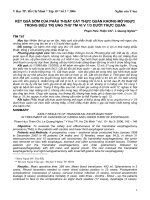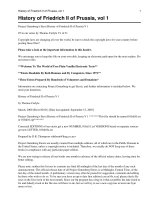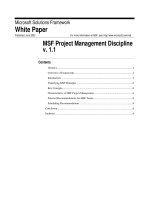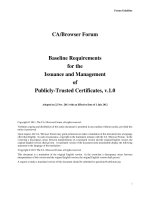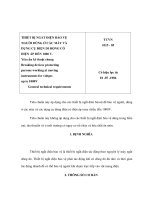Royal society of chemistry heterocyclic chemistry (v 1) royal society of chemistry (1980)
Bạn đang xem bản rút gọn của tài liệu. Xem và tải ngay bản đầy đủ của tài liệu tại đây (35.89 MB, 546 trang )
www.pdfgrip.com
Heterocyclic Chemistry
Volume 1
www.pdfgrip.com
www.pdfgrip.com
A Specialist Periodical Report
~~
Heterocyclic Chemistry
Volume 1
A Review of the Literature Abstracted
between July 1978 and June 1979
Senior Reporters
H. Suschitzky and 0. Meth-Cohn Department of Chemistry and
Applied Chemistry, University of Salford
Reporters
G. V. Boyd Chelsea College, London
G. M. Brooke University of Durham
G. P. Ellis UWIST, Cardiff
S. Gronowitz University of Lund, Sweden
D. Le Count ICI Pharmaceuticals, Macclesfield, Cheshire
P. A. Lowe University of Salford
T. J. Mason Lanchester Polytechnic, Coventry
J. M. Mellor University of Southampton
F. G. Riddell University of Stirling
R. K. Smalley University of Salford
R. C. Storr University of Fiverpool
The Royal Society of Chemistry
Burlington House, London W I V OBN
www.pdfgrip.com
British Library Cataloguing in Publication Data
Heterocyclic chemistry.(Royal Society of Chemistry. Specialist periodical reports).
VOl. 1
1. Heterocyclic compounds
I. Suschitzky, Hans 11. Meth-Cohn, Otto 111. Series
547'.59
QD400
ISBN 0-85 186-970-X
ISSN 0144-8773
RSC Members copy
ISBN 0-85404-970-3
Copyright @ 1980
The Royal Society of Chemistry
All Rights Reserved
No part of this book may be reproduced or transmitted in any form
or by any means - graphic, electronic, including photocopying, recording,
taping, or information storage and retrieval systems - without
written permission from The Royal Society of Chemistry
Set in Times on Linotron and printed offset by
J. W. Arrowsmith Ltd., Bristol, England
Made in Great Britain
www.pdfgrip.com
In trod uction
Heterocyclic Chemistry represents a vast and important area of research which is
of interest to a wide spectrum of chemists. This is amply documented by the fact
that various journals, societies, and interest groups have sprung up entirely
devoted to the pursuit of heterocyclic chemistry. Surprisingly though, there exists
to our knowledge no single periodical review alerting the reader on an annual
basis to important developments of the subject. We have now been able to
persuade the Royal Society of Chemistry to allow us to remedy this omission with
the help of eleven specialists. This new series of Specialist Periodical Reports,
apart from making economic sense, will facilitate the finding of information on
heterocyclic topics since it combines the material previously reviewed in a
piecemeal way in three different series of volumes. These were ‘Saturated
Heterocyclic Chemistry’, ‘Aromatic and Heteroaromatic Chemistry’ (both of
which are now discontinued), and the still thriving volume on ‘Organic
Compounds of Sulphur, Selenium, and Tellurium’, which has surrendered its
heterocyclic parts but will continue to report on P-lactam antibiotic chemistry.
The literature coverage is essentially based on volumes 89 and 90 (i.e.July 1978
to June 1979) of Chemical Abstracts, but, in order to provide continuity between
this new series and previous (now deleted) reports, the period covered in certain
chapters was extended accordingly. Our authors have endeavoured to include all
significant contributions in a selective and concise rather than an encyclopaedic
manner.
We have retained the newly introduced format of Volume 7 of the series
‘Aromatic and Heteroaromatic Chemistry’, i.e. proceeding from small to large
rings and giving preference to the smaller heterocycle in fused systems. Exceptionally, if the smaller ring is trivial to the chemistry of the annelated system, the
larger ring is given priority. In cases of uncertainty, both ring-chapters will carry
the information, as we felt this to be a justified overlap. Articles on ‘Bridged
Systems’ and ‘Conformation’ have been added because of their relevance to the
chemistry of saturated heterocycles. Review references are mostly quoted at the
beginning of each chapter, and the contents list has been drawn up with the aim of
serving as a broad index for easy location of points of interest. In future issues it is
hoped to follow similar schemes in each chapter as far as possible. We intend to
include reviews on specific topics of current interest from time to time.
Our authors provided us with the manuscripts in good time and we thank them
and the editorial staff of the Royal Society of Chemistry for their efficiency, which
made our own task a pleasure.
www.pdfgrip.com
vi
Introduction
The Senior Reporters, as always, would welcome comments, criticism, and
suggestions concerning this new venture.
H. SUSCHITZKY& 0. METH-COHN
Postscript: Owing to a printers’ dispute, the publishing date of this volume was
considerably delayed. This is much regretted. Volumes in this series are normally
scheduled to appear in the early Summer.
H.S. & 0.M.-C.
www.pdfgrip.com
Contents
~
Chapter 1 Three-membered Ring Systems
By T. J. Mason
1 Oxirans
Preparation
Catalytic Oxidation of Alkenes, using Oxygen
or Oxygen-containing Gases
Oxidation of Alkenes by Peroxy-acids
Catalytic Oxidation of Alkenes, using Peroxides
Halohydrin Cyclizations and Related Reactions
Syntheses Related to the Darzens Reaction
Synthesis of Chiral Oxirans
Synthesis of Fused Aromatic Oxides
Miscellaneous Syntheses
Spectra and Theoretical Chemistry
Reactions
Electrophilic Ring-opening
Kinetic studies
Cyclization reactions
Miscellaneous reactions
Nucleophilic Ring-opening
With oxygen and nitrogen nucleophiles
With carbanions
Reduction and Elimination
Thermal and Photochemical
With Organometallic Compounds
Miscellaneous
1
1
1
1
3
4
6
7
8
10
11
12
13
14
14
14
16
17
17
18
19
21
22
24
2 Oxirens
25
3 Aziridines
Preparation
Direct Insertion
Cyclizations
via Ring Contraction
Spectroscopic and Theoretical Studies
Reactions
Retention of the Aziridine Ring
Ring-opening to Acyclic Compounds
Formation of other Ring Systems
26
26
26
27
28
29
30
30
31
32
4 Azirines
Preparation
34
34
www.pdfgrip.com
...
Heterocyclic Chemistry
Vlll
Reactions
Photochemical and Thermal
Cyclization to Five- and Six-membered Heterocyclic
Systems
With Metal Carbonyls
35
35
36
37
5 Thiirans
Preparation
Reactions
Chemistry of Thiiranium Ions
38
38
39
39
6 Thiirens
40
7 Diaziridines
41
8 Diazirines
42
9 Oxaziridines
42
10 Thiazirines
44
Chapter 2 Four-membered Ring Systems
By R. C. Storr
45
1 Reviews
45
2 Systems containing One Nitrogen Atom
Azetidines and Azetines
Azetidinones
45
45
47
3 Systems containing Two Nitrogen Atoms
53
4 Systems containing One Oxygen Atom
Oxetans
2-Oxetanones (p-Lactones)
56
5 Systems containing Two Oxygen Atoms
Dioxetans
59
59
6 Systems containing Sulphur
63
7 Miscellaneous
66
Chapter 3 Five-membered Ring Systems
56
58
67
By G. V. Boyd, P. A. Lowe, and S. Gronowitz
Part I Thiophens and their Selenium and Tellurium Analogues
By S. Grono wit2
67
1 General
67
2 Monocyclic Thiophens
Synthesis by Ring-closure Reactions
68
68
www.pdfgrip.com
ix
Contents
Physical Properties
Electrophilic Substitution
Electrophilic Ring-closure Reactions
Nucleophilic Substitution
Organometallic Derivatives
Cycloadditions and Photochemistry
The Structure and Reactions of Hydroxy-, Mercapto-,
and Amino-thiophens
Side-chain Reactivities
Carbene and Nitrene Reactions
‘Benzylic’ Reactivity
Reactions of Thiophen Aldehydes and Ketones
Reactions of Carboxy- and Cyano-thiophens
Various Side-chain Reactions
Reaction at Sulphur: Thiophen Dioxides
Di- and Tetra-hydrothiophens
Bi- and Poly-heterocycles
Naturally Occurring Thiophens
Thiophen Analogues of Steroids
Thiophens of Pharmacological Interest
3 Benzothiophens and their Benzo-fused Systems
Synthesis of Benzothiophens
Physical Properties
Substitution Reactions
Side-chain Reactions
Benzo[b]thiophen S-Oxides
Benzo[c]thiophens
Dibenzothiophens
Pharmacologically Active Compounds
4 Thiophen Analogues of Polycyclic Aromatic
Hydrocarbons
Analogues of Phenanthrene
Analogues of Phenalenes and Phenalenium Ions
Thiophen-fused Tropylium Ions and Related Compounds
5 Thiophens Fused to Five-membered Heteroaromatic Rings
Thiophen- and Pyrrole-fused Thiophcns,
and Related Compounds
Pyrazole-, Thiazole-, and Isothiazole-fused Thiophens
and Related Systems
6 Thiophens Fused to Six-membered Aromatic
Heterocyclic Rings
Thiophen Analogues of Quinoline
Thiophen Analogues of Isoquinoline
www.pdfgrip.com
73
74
75
76
77
78
79
81
82
84
85
86
87
87
88
90
93
93
95
97
97
97
97
99
100
100
100
101
101
101
102
103
103
103
104
105
105
105
Heterocyclic Chemistry
X
Pyrimidine-fused Systems
Pyrazine- and Triazine-fused Systems
Miscellaneous Fused Systems
7 Selenophens and Tellurophens
Monocyclic Selenophens
Benzoselenophens and their Benzo-fused Derivatives
Selenophens Fused to Five-membered Aromatic Rings
Selenophens Fused to Six-membered Aromatic Rings
Tellurophens
Part II Systems containing Nitrogen and Sulphur, Selenium, or
TelIur ium
ByP. A. Lowe
106
107
107
107
107
108
108
109
109
109
1 Introduction and Reviews
109
2 Isothiazoles
Synthesis
From Oxathiazolones (Type B)
(Type B)
From Meso-ionic 1,3,2-0xathiazolium-5-olates
From P- Amino-cinnamates (Type C)
From Enamines and Isothiocyanates (Type C)
From Benzothiazolyldithioazetidinone(Type C)
From Thione-S-imides (Type D)
From Enamines and Perchloromethanethiol (Type E)
From y- Hydroxy-alkenesulphonamides(Type F)
Physical Properties
Chemical Properties
Alk ylation
Nucleophilic Reactions
Cycloaddition
110
110
110
111
111
111
112
112
112
112
113
113
113
113
113
3 1,2-Benzisothiazoles, their 1-Oxides, and their
1,l-Dioxides
Synthesis
Reactions
114
114
115
4 1,2-Benzisoselenazoleand 1,2-Benzisotellurazole
116
5 2,l-Benzisothiazoles
116
117
117
6 Other Condensed Ring Systems incorporating Isothiazole
Thieno[3,4-c]isothiazoles
Furano-, Thieno-, Pyrrolo-, and Pyrazolo[4,5 -d]isothiazoles
Thiazolo[4,5 -c]isothiazole
Isothiazolo[4,5-b]pyrazines
Cyclohept a[ c ]is0t hiazole
Pyrido[3’,
2’ :4,5]thieno[3,2-c ]is0 thiazole
Isothiazolo[4,3-c]quinolines
www.pdfgrip.com
117
117
117
117
118
118
Contents
xi
Isothiazolo[5,4-b]quinoline
Naphtho[ 1,2-d]isothiazoIe
Naph tho[ 2,l -d]isothiazole
Miscellaneous
7 Thiazoles
Synthesis
Hantzsch's Synthesis (Type A; S-C-N
+ S)
Type C Syntheses (C-C-N-C
Type F Syntheses (C-N-C-S
+ C)
Type G Syntheses (N-C-S-C-C)
Type J Syntheses (C-S-C-N-C)
Type K Syntheses (C-C-N-C-S)
Synthesis of Meso-ionic Thiazoles
Miscellaneous
Physical Properties
Chemical Properties
Electrophilic Reactions
Nucleophilic Reactions
Homolytic Reactions
Photochemistry
Reactions of 2-Amino-thiazoles
Reactions of Thiazolium Salts
Reactions of Meso-ionic Thiazoles
Miscellaneous
118
118
118
119
+ C-C)
119
119
119
120
120
121
121
121
121
122
122
123
123
123
123
123
124
125
125
125
8 A'-Thiazolines
Synthesis
+ C-S)
Type B Syntheses (C-C-N
Type E Syntheses (N-C-C-S
+ C)
Type K Syntheses (C-C-N-C-S)
Physical Properties
Chemical Properties
125
125
125
126
126
126
126
9 A3-Thiazolines
127
10 A4-Thiazolines
Synthesis
Reactions
127
127
127
11 Thiazolidines
Synthesis
Type A Syntheses (S-C-N
+ C-C)
Type B Syntheses (C-C-N
+ C-S)
+ S)
Type C Syntheses (C-C-N-C
Type D Syntheses (C-C-S
+ C-N)
+ C)
Type E Syntheses (N-C-C-S
Type G Syntheses (C-C-S-C-N)
Physical Properties
128
128
128
128
128
128
129
129
129
www.pdfgrip.com
xii
Heterocyclic Chemistry
Chemical Properties
Rhodanines, Isorhodanines, and Thiorhodanines
130
131
12 Selenazoles
132
13 Benzothiazoles
Synthesis
From ortho-Amino-benzenethiols (Type A;
S-C6H4-N + C)
Type B Syntheses (C6Hs-N-C-S)
Type C Syntheses (NhC6H4-S-C)
Type G Syntheses (C6H5-s-c-N)
+ S Syntheses
Type C6Hs-N-c
Physical Properties
Chemical Properties
Substitution Reactions
Addition Reactions
Alkylation
Reactions of Thiazolium Salts
Ring-cleavage Reactions
133
133
133
134
134
134
135
135
136
136
137
138
138
139
14 Condensed Ring Systems incorporating Thiazole
Structures comprising Two Five-membered Rings ( 5 3 )
Thiazolo[2,3-e]tetrazoles [CN4-C3NS]
Thiazolo-[2,3-c]- and -[3,2-b]-[1,2,4]triazoles
[C~NJ-CWI
Thiazolo[3,4,-c]oxazole [C3NO-C3NS]
Thiazolo[4,5-d]thiazoles [C3NS-C3NS]
Pyrazolo[3,4-d]thiazole [C3NS-C3N2]
Imidazo[2,1-b]thiazoles [C3NS-C3Nz]
Pyrrolo[2,1-b]thiazoles [C,NS-C4N]
Furano[2,3-d]thiazoles [C3NS-C40]
Cyclopentenothiazol-6-one[C3NS-C,]
Structures comprising One Five-membered and One
Six-membered Ring (5,6)
Thiazolo[3,2-a]- 1,3,5-triazines [C3NS-C3N3]
Thiazolo[4,5 -d]pyridazines [C3NS-C4Nz]
Thiazolo[3,2-~]pyrimidines[C3NS-C4N2]
Thiazolo-[4,5 -d] - and -[5,441-pyrimidines [C3NS-C4N2]
Thiazolo[3,4-a]pyrazines [C3NS-C4N,]
Thiazolo[4,5-b]pyrazines [C3NS-C4N2]
Thiazolo[3,2-a Ipyridines [C3NS-C5N]
Thiazolo[3,4-a]pyridines [C3NS-CSN]
Thiazolo[5,4-b]pyridines [C3NS-CSN]
Pyrano[4,3-d]thiazoles [C3NS-C50]
Structures comprising One Five-membered Ring and One
Seven-membered Ring (5,7)
Thiazolor4.5-claze~inesTC,NS-C,Nl
~
L
I
2
1
L
a
"
>
www.pdfgrip.com
139
139
139
139
140
140
140
140
141
141
142
142
142
142
142
143
143
143
143
145
145
145
145
145
...
Contents
Xlll
Structures comprising Two Five-membered Rings and One
Six-membered Ring (5,5,6)
1,2,4-Triazolo[3,4- blbenzothiazole [C3N3-C3NS-C6]
Thiazolo[2,3-b]benzothiazoles [C3NS-C3NS-C6]
Thiazolo[4,5-d]indazole [C3NS-C3N2-C6]
Benzo[ 1,2-d ; 3,4-d’]-bis-thiazoles [C3NS-C3NS-C6]
Thiazolo[3,2-a]benzimidazoles [C3NS-C3N2-C6]
Thiazolo[5,4-c]benzimidazoles [C3NS-C3N2-C6]
Imidazo[2,1-b]benzothiazoles [C3NS-C3N2-C6]
Thiazolo[3,4-a]indoles [C3NS-C4N-C6]
Thia~olo[5,4-b lindoles [C3NS-C4N-C6]
Pyrrolo[2,1-b]benzothiazoles [C3NS-C4N-C6]
Benzo[b]furano[2,3-d]thiazole [c3Ns-C40-c6]
Structures comprising One Five-membered Ring and Two
Six-membered Rings (5,6,6)
1,3,5-Triazino[2,1-b]benzothiazole [C3NS-C3N3-C6]
8-Thia-l,4-diazacyc1[3.3.2]azines[C3NS-C4N2-C4N2]
Pyrano[4,3-d]thiazolo[3,2-a]pyrimidines
[C3NS-C4N2-C50]
Pyrimido[2,1-b ]benzothiazoles [c3Ns-c4N2-c6]
Thiazolo-[2,3-b]-, - [3,2-a I-, and -[3,2-c]-quinazolines
[C,NS-C,N -C6]
Thiazolo[4,5- b]&inoxalines [C3NS-C4N2-C6]
Thiazolo-[3,2-a]-, -[4,5-g]-, -[5,4-g]-, -[4,5-h]-, and
-[5,4-h]-quinolines [c3Ns-c5N-c6]
Thiazolo-[2,3-a]- and -[3,4-b]- isoquinolines
[C3NS-CSN-CJ
Naphtho-[1,2-d]- and -[2,1-d]-thiazoles [C3NS-C6-C6]
Other Condensed Systems incorporating Thiazole
15 Thiadiazoles and Selenadiazoles
1,2,3-Thiadiazoles
Synthesis
Physical Properties
Chemical Properties
1,2,3-Selenadiazoles
1,2,4-Thiadiazoles
Synthesis
Physical Properties
Chemical Properties
1,2,4-Selenadiazoles
1,3,4-Thiadiazoles
Synthesis
Physical Properties
Chemical Properties
Condensed 1,3,4-Thiadiazoles
1,3,4-Selenadiazoles
www.pdfgrip.com
145
145
146
146
146
146
147
147
147
147
148
148
148
148
148
149
149
149
150
150
151
152
152
153
153
153
153
154
155
155
155
156
157
158
158
158
159
159
160
160
xiv
Heterocyclic Chemistry
1,2,5-Thiadiazoles
Synthesis
Physical Properties
2,1,3-Benzothiadiazoles and 2,1,3-Benzoselenadiazoles
Physical Properties
Chemical Properties
1,2,5-Thiadiazol0[3,4-g]benzofurazan
16 Dithiazoles and Diselenazoles
1,2,3-Dithiazoles
1,2,4-Dithiazoles
1,3,2-Benzodithiazoles
1,4,2-Dithiazoles
1,2,4-Diselenazoles
17 Oxathiazoles and Selenathiazoles
1,2,3-0xathiazoles
1,3,2-Oxathiazoles
1,2,4-0xathiazoles
1,3,4-Oxathiazoles
1,3,5-Oxathiazoles
1,2,4-Thiaselenazoles
18 Miscellaneous Ring Systems
1,2,3,4-Thiatriazoles
1,2,3,5-Dithiadiazoles
1,3,2,4-Dioxathiazoles
Part Ill Other Five-membered Ring Systems
ByG. K Boyd
161
161
161
162
162
162
163
163
163
163
164
164
164
165
165
165
165
166
166
166
166
166
167
167
167
1 Introduction
167
2 Reviews
168
3 Systems with One Heteroatom, and their Benzo-analogues
Furans
Formation
Reactions
Benzofurans
Formation
Reactions
Pyrroles
Formation
Reactions
Indoles and Carbazoles
Formation
Reactions
Isoindoles
Other Heterocyclic Systems
168
168
168
172
174
174
177
178
178
181
184
184
187
192
193
www.pdfgrip.com
xv
Contents
4 Systems containing Two Identical Heteroatoms
Dioxoles
1,2-Dithioles
1,3-Dithioles
Tetrathiaf ulvalenes
A Diselenole
Pyrazoles
Formation
Reactions
Indazoles
Imidazoles
Formation
Reactions
Benzimidazoles and other Annelated Imidazoles
193
193
194
197
199
200
20 1
201
201
204
205
205
205
208
5 Systems containing Two Different Heteroatoms
Oxathioles and Oxaselenoles
Isoxazoles
Formation
Reactions
Benzisoxazoles
Oxazoles
Formation
Reactions
Benzoxazoles
Other Systems
209
209
211
211
213
215
2 16
216
217
219
220
6 Systems containing Three Identical Heteroatoms
Trithiolans
1,2,3-Triazoles and Benzotriazoles
1,2,4-Triazoles
220
220
220
222
7 Other Systems containing Three Heteroatoms
Oxadiazoles
1,2,3-0xadiazoles
1,2,4-0xadiazoles
1,2,5-0xadiazoles
1,3,4-Oxadiazoles
Thiadiazoles
1,2,3-Thiadiazoles
1,2,4-Thiadiazoles
A 2,1,3-Benzothiadiazole
1,3,4-Thiadiazoles
Selenadiazoles
1,2,3-Selenadiazoles
Other Selenadiazoles
Other Systems in which Two of the Three Heteroatoms
are Identical
Systems containing Three Different Heteroatoms
223
223
223
224
225
226
226
226
227
228
228
228
228
229
www.pdfgrip.com
229
232
xvi
Heterocyclic Chemistry
8 Systems containing Four Heteroatoms
Tetrazoles
1,2,3,4-ThiatriazoIes
Miscellaneous Systems
232
232
233
234
9 Compounds containing Two Fused Five-membered
Rings (5,5)
Systems containing Oxygen and/or Sulphur
Nitrogen Systems
Monoaza-compounds
Diaza-compounds
Triaza-compounds
Tetra-aza-compounds
Penta- and Hexa-aza-compounds
Mixed Oxygen, Nitrogen Systems
Other Mixed Systems
235
235
236
236
237
239
239
239
240
241
10 Compounds containing Fused Five- and Six-membered
Rings (5,6)
Nitrogen Systems
Monoaza-compounds
Diaza-compounds
Triaza-compounds
Tetra-aza-compounds
Penta- and Poly-aza-compounds
Compounds containing Oxygen and Nitrogen
Other Mixed Systems
242
242
242
243
245
247
249
250
252
11 Compounds containing Fused Five- and Sevenmembered Rings (5,7)
Nitrogen Systems
Monoaza-compounds
Diaza-compounds
Triaza-compounds
Tetra- and Penta-aza-compounds
Other Systems
252
252
252
253
254
254
255
Chapter 4 Six-membered Ring Systems
By G.P. Ellis and R. K. Smalley
Part I Azines, Oxazines, and Thiazines
By R. K. Smalley
257
257
1 Reviews
257
2 Azines and their Hydro- and Benzo-derivatives
Pyridines
Synthesis
Reactions
258
258
258
263
www.pdfgrip.com
Conten fs
xvii
Hydro-p yridines
Quinoline, Isoquinoline, and their Benzo- and Hydroderivatives
3 Diazines and their Hydro- and Benzo-derivatives
Pyridazines, Cinnolines, and Phthalazines
Pyrimidines and Quinazolines
Pyrazines and Quinoxalines
Purines, Pteridines, and Related Systems
Other Systems with Two Nitrogen Atoms
275
282
293
293
296
304
308
316
4 Triazines and Tetrazines
320
5 Oxazines, Thiazines, and their Benzo-derivatives
323
6 Oxa- and Thia-diazines and Related Systems
327
Part II Other Six-membered Ring Systems
By G.P. Ellis
329
1 Books and Reviews
329
2 Systems containing One Oxygen or Sulphur Atom
Reduced Pyrans
Pyrans
Pyrones
Preparation
Properties
Pyrylium salts
Thiopyrans
Synthesis
Reactions
Chromans
Isochromans
Chromenes
Chromanones
Chromones
Thiochromans, Thiochromenes, Thiochromanones, and
Thiochromones
Flavans and Isoflavans
Isoflavenes
Flavanones
Isoflavanones
Flavones
Isoflavones
Dihydrocoumarins
Coumarins
Isocoumarins
Thiocoumarins
Xanthenes
330
330
332
333
333
336
337
340
340
34 1
34 1
343
344
345
346
www.pdfgrip.com
349
350
350
351
352
353
356
358
358
362
363
363
xviii
Heterocyclic Chemistry
364
365
Thioxanthenes
Xanthones
3 Systems containing Two or More Oxygen or Sulphur
Atoms
Oxathians and their Benzo-derivatives
Dioxans and Benzodioxans
Dithians and Related Compounds
Systems consisting of Two or More Oxygen-containing
Rings
Cannabinoids
Rotenoids
Other Natural Compounds
Synthetic Compounds
Systemscontaining Oxygen and Sulphur in Different Rings
370
370
371
372
374
374
4 Systems containing Phosphorus as a Heteroatom
375
5 Systems containing Silicon or Selenium as Heteroatoms
375
Chapter 5 Seven-membered Ring Systems
By D. J. Le Count
367
367
368
370
377
1 Introduction
377
2 Reviews
377
3 Systems containing One Heteroatom
One Nitrogen Atom
One Oxygen Atom
One Sulphur Atom
Other Systems
377
377
389
392
395
4 Systems containing Two Heteroatoms
Two Nitrogen Atoms
Nitrogen and another Heteroatom
0t her Systems
395
395
405
408
5 Systems containing Three or More Heteroatoms
410
Chapter 6 Eight-membered and Larger Ring Systems
By G.M. Brooke
1 Eight-membered Rings
One Heteroatom
Two Heteroatoms
Three or More Heteroatoms
2 Nine- and Ten-membered Heterocycles
www.pdfgrip.com
411
411
41 1
412
414
416
xix
Contents
3 Macrocycles
Systems containing Nitrogen only
One Nitrogen Atom
Two or Three Nitrogen Atoms
Four Nitrogen Atoms
Five or More Nitrogen Atoms
Systems containing Nitrogen and Other Heteroatoms
Systems containing Heteroatoms other than Nitrogen
Crown Ethers and Related Compounds
Syntheses
Effects on Chemical Reactions
Reactions of the Macrocyclic Rings
Formation of Host-Guest Complexes
Chapter 7 Bridged Systems
By J. M.Mellor
419
419
419
420
422
424
425
426
429
429
430
432
434
439
1 Introduction
439
2 Reviews
439
3 Physical Methods
X-Ray and Neutron Diffraction
Photoelectron Spectroscopy and Related Electrochemical
Studies
Nuclear Magnetic Resonance Spectroscopy
Electron Spin Resonance Spectroscopy
Miscellaneous
440
440
4 Nitrogen Compounds
Synthesis
Tropane Derivatives and Related Azabicyclo[3.2. lloctanes
Other Alkaloid Syntheses
Cycloadditions
Cyclizations with Nucleophilic Nitrogen
Cyclization via Radical Intermediates
Cyclization via Electrophilic Nitrogen
Reactions
Bridged Azoalkanes
445
445
446
449
450
455
456
456
457
458
5 Oxygen Compounds
Cycloadditions
Miscellaneous Syntheses
Bridged Peroxides
459
459
461
462
6 Sulphur Compounds
Cycloadditions
Miscellaneous Syntheses
463
463
464
www.pdfgrip.com
442
444
445
445
Heterocyclic Chemistry
xx
7 Bridged Annulenes and Related Systems
464
8 Cyclophanes
464
9 Cryptands and Cryptates
466
Chapter 8 Conformational Analysis
By F. G. Riddell
469
1 Introduction
469
2 Four-membered Rings
469
3 Five-membered Rings
470
4 Six-membered Rings
Oxygen-containing Rings
Nitrogen-containing Rings
Sulphur-containing Rings
Phosphorus-containing Rings
Boron- and Silicon-containing Rings
470
470
472
476
478
480
5 Seven-membered Rings
481
6 Eight-membered Rings
48 1
7 Nine-membered and Larger Rings
482
8 Polycyclic Systems
484
489
Author Index
www.pdfgrip.com
1
Three-membered Ring Systems
BY T. J. MASON
The last Report on three-membered heterocyclic rings to appear in one of the
Specialist Periodical Reports series concerned only saturated systems and
covered material published in 1975.l The scope of this Report has been extended
to include unsaturated systems, and some articles published between 1975 and
the current review have been included here to attempt to bridge the gap in
coverage.
1 Oxirans
Preparation.-Catalytic Oxidation of Alkenes to Oxirans, using Oxygen or O x y gen-containing Gases. The use of supported silver catalysts for the gas-phase
epoxidation of ethene continues as an area of active investigation. Improvements
in the selectivity of the reaction may be attained by doping the silver with trace
quantities of other metals; e.g., 0.2 atom O/O of Na or K, or 0.003% of Cs or Rb,
. ~
may also be improved by the
increase selectivity to around ~ O O / O Selectivity
addition of 1,2-dichloroethane to the gases; this retards the formation of CO, and
H 2 0 . It is reported that HCI (produced by the dehydrochlorination of the
chloro-alkane) reacts with chemisorbed atomic oxygen on the silver catalyst to
form chemisorbed atomic ~ h l o r i n e .The
~ kinetics of such a reaction, in the
presence of dichloroethane, have been reported, and rates of both oxidation and
epoxidation depend on the concentrations of ethene and ~ x y g e n . ~
The palladium complex [PdCl,{P(C,F,),},] has been found to give a selectivity
of more than 60% in the epoxidation of ~ r o p e n eA
. ~mixtiire of 43.1% propene,
54.4% hydrogen, and 2.5% oxygen was passed through the catalyst in 1,2dichlorobenzene and water at 67 “C and 15.8 atm pressure; no carbon dioxide
was formed.
Photosensitized epoxidation has received considerable attention over the past
few years. Since 1974, many cases have been reported in which photo-epoxida-
’
T. J. Mason, in ‘Saturated Heterocyclic Chemistry’, ed. G. Pattenden, (Specialist Periodical
Reports), The Chemical Society, London, 1978, Vol. 5, p. 1.
W. D. Mross, E. Titzenthaler, M. Schwarzmann, and J. Koopman, Ger. Offen. 2 704 197 (Chem.
Ah.,1978,89, 163 381).
P. Kripylo, L. Gerber, P. Muench, D. Klose, and L. Beck, Chem. Tech. (Leiprig) 1978, 30, 630
(Chern. Abs., 1979,90,103 080).
A. Gawdzik and J. Wasilewski, Chem. Stosow., 1978,22,13 (Chem. Abs., 1978,89 89 924).
P. N. Dyer, Ger. Offen. 2 746 812 (Chem. Abs., 1978,89,43 091).
1
www.pdfgrip.com
2
Heterocyclic Chemistry
tion competes with the usual reactions of singlet oxygen,6 the reaction being
influenced by, among other factors, the nature of the photosensitizer.' An
example is the reaction of bisadamantyl with oxygen in acetone solvent; sensitization by methylene blue yields more than 95% of 1,2-dioxetan whereas more
than 95% of the epoxide is formed with rose bengal as sensitizer. The photooxygenation of a-pyronene (1)with tungsten lamps using methylene blue yields
peroxide (2), which may be reduced by Ph3P, in a low-yield reaction, to the
epoxide (3).8 The epoxide (4) is directly produced by oxidation of (1) with
perbenzoic acid. Dimethylstyrene (5) and tetraphenylporphine (a dye photosensitizer), when irradiated in CCl, using sodium lamps, react with oxygen to give a
mixture of products containing 30% of the diperoxide (6),which on refluxing in
benzene gave epoxide (7) (65%).'
om
r7J-f
0°0
\
0
The cleanest photo-epoxidations occur using a-diketones as sensitizers. lo The
for the
mechanism of the reaction has been investigated by Bartlett, using
epoxidation of norbornene." With benzil or biacetyl as sensitizers, the results
suggested the intermediacy of a diradical species such as (8;R = Me or Ph) in the
reaction. Attempted photo-epoxidation of vinyl-allenes using biacetyl as sensitizer yielded little or no epoxide, but resulted in a good and efficient method of
converting such compounds into cyclopentenones.12 The yields of cyclopentenones (10)isolatedfrom the allenes (9; R1 = But, R2 = H), (9; R' = C5Hll,
R2 = H), and (9; R' = C4H9,R2 = H) being 40, 55, and 6O%, respectively.
A mechanistic investigation of the acenaphthenequinone-sensitized photoepoxidation of alkenes has been r e p 0 ~ t e d . lPhotolysis
~
of the quinone in
dichloromethane that was continuously saturated in oxygen generated 1,snaphthalic anhydride in 80% isolated yield. When cyclohexene was included in
lo
P. D. Bartlett and M. S. Ho, J. A m . Chem. SOC.,1974,96,627.
C . W. Jefford and A. F. Boschung, Helu. Chim. Ada, 1977,60, 2673.
W. Cocker, K. J. Crowley, and K. Srinivasan, J. Chem. Soc., Perkin Trans. 1, 1978, 159.
M. Matsumoto and K. Kuroda, Japan. Kokai 78 68 789 (Chem. Abs., 1978,89, 197 559)
N. Shimizu and P. D. Bartlett, J. A m . Chem. SOC.,
1976,98, 4193.
l1
P. D. Bartlett and 3. Becherer, Tetrahedron Lett., 1978,2983.
l2
l3
M. Malacria and J. Gore, J. Org. Chem.. 1979,44,885.
J-Y. Koo and G. B. Schuster, J. Org. Chem., 1979,44, 847.
www.pdfgrip.com
3
Three-membered Ring Systems
the reaction solution it was converted into a mixture of oxidized products
consisting mainly of allylic hydroperoxide (40%) and epoxide (33%). A possible
(8)
(9)
(10)
mechanism was proposed (Scheme 1) involving the diradical intermediate (11)
obtained by either C- or O-oxidation. It was suggested that this intermediate
could yield O3by further reaction with O2and thus account for the small amount
of adipaldehyde formed in the reaction.
a* a
I
4%
0'
/
0
\
/
\
.?I
/
0-0'
Scheme 1
Oxidation of Alkenes to Oxirans by Peroxy-acids. The use of peroxy-acids in the
Vinyloxiran (12)
epoxidation of unsaturated compounds has been re~iewed.'~
was prepared in 95% yield by the reaction of peroxypropanoic acid with
butadiene in benzene at 40 OC.15The same peroxy-acid, continuously generated
by the reaction of propanoic acid with hydrogen peroxide, has been used in the
'*
l5
E. L. Gershanova, E. I. Stratonova, M. F. Sorokin, and Z. A. Mikhitarova, Deposited Document
1976, VINITI 792 (Chem. Ah., 1978,88,61683).
G. Rauleder, H. Seifert, H. Waldmann, W. Schwerdtel, and W. Swodenk. Ger. Offen. 2 734 242
(Chem. A h . , 1979,90, 168 429).
www.pdfgrip.com

